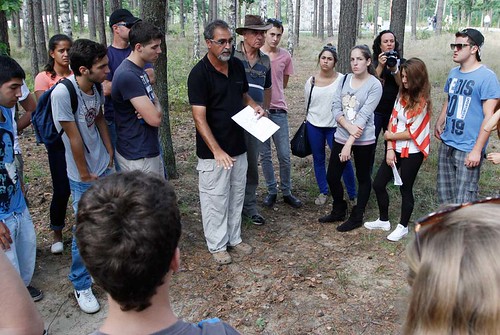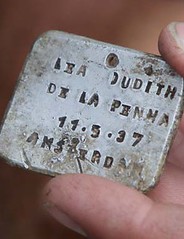
PREV ARTICLE
NEXT ARTICLE
FULL ISSUE
PREV FULL ISSUE
SOBIBOR NAZI DEATH CAMP ARTIFACTS FOUND
When I saw the below image of an identification tag it reminded me of the slave tags sometimes seen in auction of U.S. colonial-era coins. This image was connected to a story on archeology of the Holocaust, specifically work being done by an Israeli archaeologist
at the site of the Sobibor Nazi death camp.
After learning that two of his uncles were murdered in the infamous Sobibor death camp, he embarked on a landmark excavation project that is shining new light on the workings of one of the most notorious Nazi killing machines, including pinpointing the location of the gas chambers where hundreds of thousands were killed. Sobibor, in eastern Poland, marks perhaps the most vivid example of the "Final Solution," the Nazi plot to wipe out European Jewry. Unlike other camps that had at least a facade of being prison or labor camps, Sobibor and the neighboring camps Belzec and Treblinka were designed specifically for exterminating Jews. Victims were transported there in cattle cars and gassed to death almost immediately. But researching Sobibor has been difficult. After an October 1943 uprising at the camp, the Nazis shut it down and leveled it to the ground, replanting over it to cover their tracks. Today, tall trees cover most of the former camp grounds. Because there were so few survivors — only 64 were known — there has never been an authentic layout of the camp, where the Nazis are believed to have murdered some 250,000 Jews over an 18-month period. From those few survivors' memories and partial German documentation, researchers had only limited understanding of how the camp operated. "I feel like I am an investigator in a criminal forensic laboratory," Haimi, 51, said near his home in southern Israel this week, a day before departing for another dig in Poland. "After all, it is a murder scene." Over five years of excavations, Haimi has been able to remap the camp and has unearthed thousands of items. He hasn't found anything about his family, but amid the teeth, bone shards and ashes through which he has sifted, he has recovered jewelry, keys and coins that have helped identify some of Sobibor's formerly nameless victims. The heavy concentration of ashes led him to estimate that far more than 250,000 Jews were actually killed at Sobibor. "Because of the lack of information about Sobibor, every little piece of information is significant," said Haimi. "No one knew where the gas chambers were. The Germans didn't want anyone to find out what was there. But thanks to what we have done, they didn't succeed." The most touching find thus far, he said, has been an engraved metal identification tag bearing the name of Lea Judith de la Penha, a 6-year-old Jewish girl from Holland who Israel's Yad Vashem Holocaust memorial confirmed was murdered at the camp.

To read the complete article, see:
Israeli archaeologist Yoram Haimi digs into the infamous Sobibor Nazi death camp
(artdaily.com/index.asp?int_sec=2&int_new=57270#.UDSt9d1lTIg)
The Numismatic Bibliomania Society is a non-profit organization promoting numismatic literature. See our web site at coinbooks.org. To submit items for publication in The E-Sylum, write to the Editor at this address: whomren@gmail.com To subscribe go to: https://my.binhost.com/lists/listinfo/esylum All Rights Reserved. NBS Home Page Contact the NBS webmaster 
|
